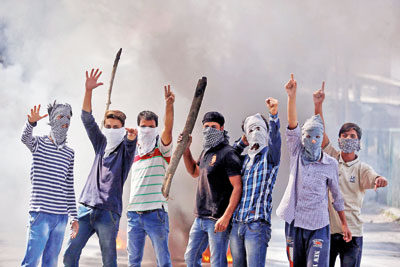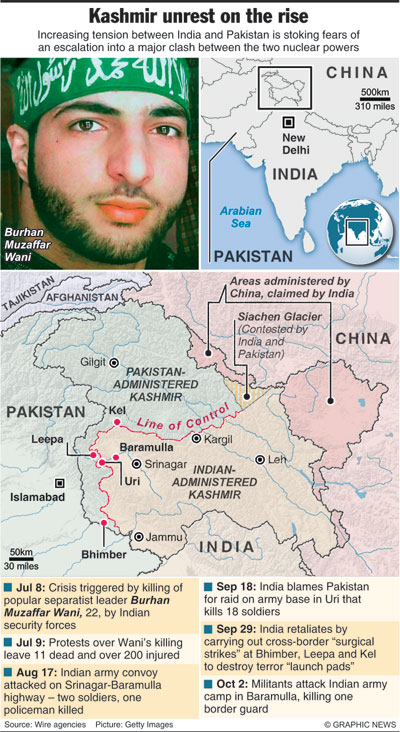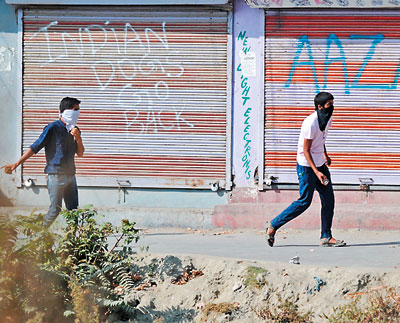Sunday Times 2
What actually happened in Kashmir?

Masked demonstrators shout pro-freedom slogans in front of a burning tyre during a protest in Srinagar
Deep into the moonless night of Wednesday, September 28, according to Indian officials, two battalions of Indian commandos stole over the Line of Control, the de facto border that separates India and Pakistan in Kashmir. On foot, they reached a series of so-called “launch pads”— improvised structures where jihadist militants had assembled, so that they might more easily slip across border to conduct attacks in India. Using grenades and rocket-launchers, the Indian commandos destroyed the launch pads, killing an unknown number of militants in the process. By 4:30 a.m., the commandos had returned to Indian soil; on the way home, one soldier was wounded lightly by an exploding mine.
The mission marked the culmination of days of anxiety along the Line of Control. A week and a half earlier, militants in Pakistan had attacked an army base in Uri, a region of Kashmir that lies six miles east of the Line of Control, killing 19 soldiers—the highest death toll suffered by the Indian military in a terrorist assault in decades. Narendra Modi, India’s prime minister, vowed that the episode “would not go unpunished.” His home minister called Pakistan “a terrorist state”—one further iteration of the common knowledge that Islamabad’s security apparatus foments and facilitates cross-border terrorism in Kashmir.
A week after India’s raid on the launch pads, the immediate alarm that it would tip India and Pakistan into war has faded. On Monday, a Pakistani government spokesperson announced that the national security advisors of the two countries had spoken on the phone, and that they had agreed to try to defuse tensions along the Line of Control. But the operation marks an inflection point in Modi’s Pakistan policy, one that he began outlining three years ago, when he started campaigning to be prime minister.
Details about the commando mission remain oddly sketchy. A short statement issued by the Indian military said that its intelligence agencies had received “very specific and credible information” about an impending terrorist attack. The commandos’ “surgical strikes at several of these launch pads” caused “significant casualties,” the statement added; it specified nothing further. (Additional facts about the operation have only emerged in subsequent, anonymously sourced media reports.) In a twist, Pakistan denied altogether that such an operation even transpired. The night of September 28 was quiet except for a near-routine bout of shelling and some exchange of small-arms fire across the Line of Control, Pakistani officials insisted. Correspondents for the The New York Times and the Washington Post managed to get close enough to Pakistan’s side of the Line of Control to interview villagers who testified that no Indian troops had crossed over.
If these surgical strikes did indeed occur, they wouldn’t have been India’s first inside Pakistan-held territory. In recent decades, India’s army and intelligence agents have penetrated the Line of Control to hit key positions occupied by terrorists or Pakistani soldiers, as part of the longstanding tussle over Kashmir. In his book Avoiding Armageddon, the Brookings Institution’s Bruce Riedel recounted the spectacular 1988 explosion of an arsenal just outside Rawalpindi, nearly 200 miles from the border with India. “In 2012 two former Indian officers told me that it was their service that sabotaged the facility to punish Pakistan for helping the Kashmiri and Sikh rebels,” Riedel wrote.
What was different about the operation on September 28, however, was the Indian government’s eagerness to talk about it. An Indian army official held a press conference hours after the attack concluded. The home minister chaired a meeting of all national political parties to give them details about the mission. India’s foreign secretary, S. Jaishankar, briefed the ambassadors of 25 countries within a day of the surgical strikes. Through India’s long engagement in Kashmir, this was the first time the government publicly announced the results of an ostensibly covert maneuver.
The energy of this communication suggested that the strikes were, in large part, conducted with a domestic audience in mind. In recent months, Modi has faced increasing pressure to uphold his reputation for toughness, as well as his Bharatiya Janata Party’s (BJP) credibility for giving Pakistan no quarter. India rattled its sabres less for the sake of deterrence—similar strikes in the past had no impact on Pakistan’s fondness for nurturing militants and implicitly sanctioning their violence—and more as a public-relations exercise.
When Narendra Modi began his election campaign, he projected himself as the quintessential strongman, planning to whip the government into shape through the sheer force of his character. He spoke frequently about the need to deal with Pakistan and its state-backed terrorism firmly, and to recognize the limits of mere diplomacy. “A lot of people die in terrorist attacks. Pakistan beheads our soldiers on our soil. Yet Delhi is holding talks with Pakistan over chicken biryani,” Modi scoffed in September 2013. The BJP, rooted in Hindu nationalism, has traditionally advocated greater aggression against Pakistan. While the party’s manifesto for the 2014 election mentioned Pakistan only twice, one of its key foreign policy planks left little room for doubt: “In our neighborhood we will pursue friendly relations. However, where required we will not hesitate from taking [a] strong stand and steps.”
But foreign policy is too large a battleship to turn around that easily, and the BJP was coming to power after the 10-year prime ministership of Manmohan Singh, who was keen on maintaining civil and pacific relations with Pakistan. After Modi’s victory in May 2014, his stance softened. He invited Pakistan’s Prime Minister Nawaz Sharif, as well as other South Asian leaders, to his inauguration ceremony in New Delhi; later, Sharif sent along a sari as a gift for Modi’s mother. On the sidelines of the Paris climate talks, the two leaders agreed to begin a comprehensive dialogue. Weeks later, on Sharif’s birthday, Modi paid a surprise visit to Lahore while returning to India from Afghanistan. “That’s like a statesman,” Modi’s foreign minister tweeted approvingly. “This is how it should be with neighbors.”
Modi maintained his pacified tone even after an attack on an Indian Air Force base on January 2. Six militants climbed over the perimeter wall of the station in Pathankot, near the border in Punjab, and in a gun battle that lasted for hours, seven military personnel were killed. In the aftermath, India and Pakistan agreed to postpone a scheduled round of talks. In a gesture without precedent, the Indian government also permitted a five-member investigation team from Pakistan to visit Pathankot. When the team’s report claimed that the attack was a “false flag” operation, orchestrated by India to malign Pakistan, India shrugged off these conclusions. Three weeks later, New Delhi resumed talks with Islamabad.
The decision to press on with diplomacy—“love letters,” as Modi scorned the process in 2009—was applauded by several Indian commentators as mature and cool-headed. Within the BJP’s nationalist support base, however, it was interpreted as weakness. For the party’s diehards, it deviated too much from their sustaining mythology. On social media, disappointed outrage-merchants called Modi “spineless” and “incompetent.” The Shiv Sena, one of the BJP’s coalition allies, accused the government of being deluded. “Whoever becomes the prime minister, they immediately become obsessed with Pakistan and how to engage with it despite grave provocations,” Sanjay Raut, a Shiv Sena parliamentarian said. “I didn’t expect it from this government, but it too seems to be going down the same road.” Ajai Sahni, a counter-terrorism analyst, wondered: “Where is our national pride?”
Since then, Modi has weathered a torrid summer in Kashmir. At least 70 civilians and two policemen were killed in demonstrations that began in early July, after Indian troops shot dead a popular young militant named Burhan Wani. Crowds congested the streets of Kashmir’s towns, throwing stones and demanding that the army shrink its presence in the valley or even that India leave Kashmir altogether. For weeks on end, security forces seemed unable to suppress the protests altogether, despite the extensive use of pellet guns, a weapon classified as “non-lethal” and capable of spraying dozens of small metallic balls at high velocity. (One hospital in Srinagar had to perform more than 400 eye surgeries on pellet-gun victims, sparking protests from doctors over the weapon’s indiscriminate use.) The attack in Uri occurred just as the protests across Kashmir had abated somewhat. It was within this climate that the Indian government ordered the midnight excursions into Pakistan-held Kashmir.
The risks of runaway escalation from that operation have now diminished. The genuine quandary now appears to be the Indian government’s policy of future reaction. Power once projected is difficult to contain. In openly announcing this set of strikes, the Indian government has committed itself to responding in like fashion to the next attack, or the one after that, or the ones further still down the line. In the attempt to reap immediate political capital through the display of a strong hand, the government may well have locked itself into a single course of action.
Courtesy The Atlantic
| Mystery of the ‘surgical strike’ By Zahid Hussain  Kashmiri protestors throw stones towards Indian government forces in clashes during a protest against the death of civilians in Kashmir's ongoing summer unrest, in Srinagar on October 7 IT cannot get more absurd. While the Indians insist that they carried out a cross-LoC surgical military strike, the Pakistanis are befuddled by the claim. Either the Indians are hallucinating or the Pakistanis are in a complete state of denial. The riddle gets more confusing with the Indian claim of having destroyed ‘terrorist camps’ a few kilometres inside Azad Kashmir killing dozens of militants, and the Pakistani security forces unofficially claiming to have captured one Indian soldier who ‘strayed’ into our part. The mystery thickens. There is no evidence substantiating the Indian boast of conducting cross-LoC preventive strikes demonstrating their new aggressive approach. This according to some Indian analysts, redefines its nuclear threshold. There has certainly been an incessant exchange of fire between the two forces along the Line of Control over the past one week leaving two Pakistani soldiers dead. However, there has not been any clear answer by the Indian officials about where exactly the targeted camps were located. They have reportedly released some grainy videos of the operation feeding into the jingoistic frenzy of the local media. But that has failed to clear doubts. Surely the Indian claim has far too many holes — but so does our story. Intriguingly, Pakistan has maintained a low profile throughout the crisis, focusing entirely on falsifying the Indian claims of a surgical strike. One may argue that it was not in our interest to cause the situation to escalate thus falling into the Indian trap. But there was no rationale in glossing over some facts that were already in the public domain. There is not one official confirmation of the report about the capture of the Indian soldier. In fact, it was an Indian minister who broke the news. Later, Ambassador Maleeha Lodhi mentioned the incident in her speech at the United Nations. There was no word, however, from the military spokesman who is otherwise eager to comment on every subject. It is still not clear how the Indian soldier was captured if there was no incursion inside our territory. It is hard to buy the argument that the soldier just strayed into our territory crossing over the tight security fencing. All this is quite puzzling. Initially, the Indian officials indicated that helicopters were used in the surgical operations, but they soon backtracked saying there were no aerial strikes and the cross-LoC operation just involved ground troops. The Indian forces apparently launched attacks simultaneously on several positions and reportedly the fire was promptly responded to by Pakistani troops. Indeed, Indian military officials have not provided full details about the number of targets or the number of casualties, nor have they identified them. Undoubtedly, there is much ambiguity over what the surgical strikes by the Indian forces achieved exactly. But there is some indication that the Indian troops did come inside our territory, though it is not clear how far they penetrated. Of course, incursion by the rival troops on both sides of the LoC is not unusual and there are some recent examples. But the context and scale of the latest infringement, and the fact that the Modi government has chosen to publicly announce it, has completely changed the situation. While in the past, neither side would acknowledge an incursion, it was different this time with New Delhi brazenly owning the act of aggression. Our response uncharacteristically has simply been to repudiate ‘Indian lies’. It may be true that the Modi government has begun a trend of making exaggerated claims of conducting preventive strikes across its borders. One recent example was its claim to have destroyed the Naga rebel camps in an ambush inside Myanmar in 2015. That so-called surgical strike provoked huge criticism in India after some reports revealed that there were no rebel camps in that area. But while trying to prove New Delhi’s claim wrong, perhaps we have deliberately ignored the message behind the Indian belligerence. It is not important whether technically speaking it was a surgical strike or just an incursion. The real issue is that the Modi government has set a new and dangerous precedent signalling its willingness to go to the extreme in the event of any militant strike on its soil in the future. It is what is described as Modi’s doctrine of aggressive diplomacy. Indeed, the Modi government has been under pressure to up the ante after the Uri military camp attack to pacify public opinion that has been fed on the intense anti-Pakistan sentiments whipped up by the right-wing government itself. But the latest aggression was not just for local consumption. It was also meant to send a clear message to the international community about India’s new and more aggressive approach to deal with Pakistan. New Delhi’s growing influential position on the world scene has encouraged the Modi government to take a more reckless path. “The Modi government wants to redefine the idea of ‘no escalation beyond’ the nuclear threshold. It believes the nukes have become a one-sided deterrent or a kind of umbrella under which Pakistan can carry out low-level activity to bleed India,” writes Shekhar Gupta, a leading Indian journalist. Some Indian analysts believe that Modi is willing to call what they describe as “Pakistan’s tactical nuclear bluff”. What is most worrisome is that there seems to be little understanding in Islamabad about Modi changing even more than just the rules of the game. Surely, the growing perception of Pakistan’s diplomatic isolation has given further impetus to Modi getting more adventurous. So far our response to the grave challenge has remained incoherent and patchy. We have failed even to present our case effectively to the international community and there is little hope of things changing for us. Although the two sides seem to have agreed to de-escalate the situation, it may not be too long before it flares up again. (The writer is an author and journalist.) Courtesy Dawn, Pakistan |

